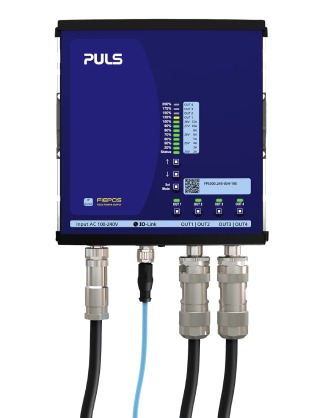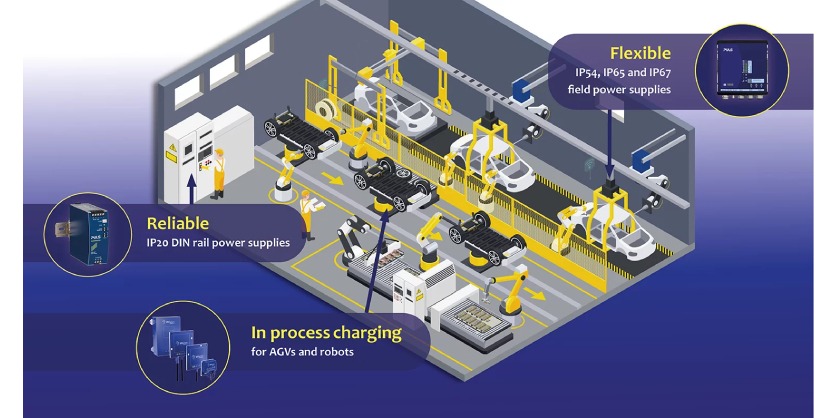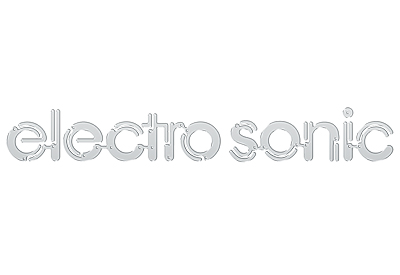More Electric Drives, Less Pneumatics: What Does this Mean for the Power Supply?
January 7, 2025

The shift from pneumatic to electric drives is a well-known development in the industry. However, in recent years, this topic has gained significant momentum. This is due to the continuously increasing cost pressure and the ever-stricter requirements for CO2 reductions. In both areas, the advantages of electric solutions prevail. This blog article illustrates, using the example of OEMs in the automotive industry, how smart industrial power supplies support the transition from pneumatic to electric drives.
Electric and pneumatic drives each have their advantages and disadvantages.
Pneumatic drives are inexpensive to purchase, easy to operate, offer high overload resistance, and are robust against environmental conditions such as temperature fluctuations and increased dust exposure. However, pneumatic drives require a central, continuous compressed air generation, which involves significant effort. It is necessary to distribute and maintain a consistent pressure throughout the entire factory. If there is a loss of compressed air due to a leak in the system, it must be quickly identified and repaired, which entails high maintenance efforts.
Especially in applications with many switching cycles, the high energy losses due to poor efficiency are significant during operation. Even in modern compressed air systems, the majority of energy is lost as waste heat. Additionally, the compressed air system must always be ready for use and therefore in operation, which results in high energy consumption. This leads to generally high operating costs and CO2 emissions.
Electric drives combined with servo motors offer better energy efficiency and enable high speed and precision. Thanks to integrated microprocessors, most electric components have a bigger range of functions and allow access to application data in connection with a central monitoring system. Operating costs are generally lower, and the CO2 footprint can be sustainably reduced. Additionally, electricity can be easily distributed in the factory – almost without losses. The ability to convert and store electricity is another advantage. New technologies, such as wireless energy transmission, also come into play. Electric solutions are also significantly quieter, which reduces noise pollution for the workforce.
However, electric drives are more expensive to purchase. Additionally, the systems are more complex compared to pneumatic solutions and may require retrofitting existing equipment.
OEMs are generally cautious about changes to proven systems. But the economic, political, and social pressure regarding energy efficiency is prompting more and more manufacturers to opt for the purely electric route. Therefore, new industrial plants often omit the installation of a pneumatic system right from the start. As is often the case, the automotive industry and its suppliers are taking a pioneering role in this regard. The numerous projects to switch from pneumatics to electricity that PULS has accompanied in this segment had one thing in common: the right power supply system is crucial for success.
Decentralized power supply of conveyor systems

In the automotive industry, everything from large body parts and heavy engines to components from the small parts warehouse is transported via kilometer-long conveyor belts and driverless transport systems. In the BMW plant in Regensburg, Germany the assembly lines alone have a total length of 5.5 km.
When the stoppers, diverters, as well as lifting and rotating units in conveyor systems are converted from pneumatic to electric drives, a decentralized and protected power supply is ideally suited. In order to realize this, space-saving and powerful power supplies with sufficient power reserves are needed directly in the field. Long, loss-prone supply lines are eliminated, and flexibility is increased.
PULS has developed the product category ‘Field Power Supplies’ for this purpose, which consists of 360 W and 600 W power supplies with high protection classes IP54, IP65 and IP67, as well as many different connector options.
Additional features, such as up to four integrated current-limited outputs, ensure the safety of electrical consumers. With these eFuses integrated into the power supply, it is possible to realize selective power distribution, protection, and monitoring outside the control cabinet.
The Field Power Supplies are very robust both mechanically and electrically, and resistant to harsh environmental conditions such as moisture, dust exposure, and vibrations.
Sufficient power reserves for dynamic motion sequences
For cobots, smaller robots, and decentralised applications in the automotive industry, electric drives have also become the first choice.
A reason for that is also the significant technological advances in electric motors. In recent years, these have contributed to making electric drives a real alternative to pneumatics. The motors generate a lot of power with small dimensions and weight. However, the rapid movements that electric motors enable, for example in robotic applications, require power supplies that can not only handle higher loads in the short term but also process the resulting regenerative energy.
Many PULS power supplies have generous power reserves, known as BonusPower. Numerous DIN rail power supplies from the proven DIMENSION product family provide up to 150 % power for 4 seconds. The FIEPOS field power supplies also achieve 200 % power for 5 seconds thanks to BonusPower. Upcoming product families for DIN rail mounting, currently in development, will even surpass these values in terms of peak performance and dynamics.
Thanks to the generous power reserves, oversizing of the power supply is unnecessary, resulting in cost and space savings.
Wireless charging of autonomous guided vehicles and mobile robots
Loss-prone pneumatic drives are becoming increasingly rare in autonomous guided vehicles (AGVs) and industrial trucks. Instead, manufacturers are also relying on electric solutions here, which are better suited for mobile applications. However, for efficient power supply and battery charging during operation, an appropriate charging infrastructure is needed in the factories first.
Several leading automotive manufacturers are already using the innovative wireless charging technology from the PULS Business Unit Wiferion for charging AGVs and cobots.
Wiferion’s contactless charging technology allows these vehicles to remain continuously in operation without disruptive charging breaks or manual interventions. Wireless charging offers significant advantages over conventional charging systems, such as the elimination of mechanical wear or the risk of tripping hazards from cables or contact strips.
With Wiferion’s etaLINK and CW systems, AGVs and mobile robots can be efficiently and autonomously charged during their normal work cycle, such as during short stops at stations. The elimination of long downtimes for energy intake increases the fleet availability significantly. The energy transfer takes place directly via charging pads, which allow for high positioning tolerance and start the charging process in less than a second.
With the established 3 kW and the new 1 kW systems, Wiferion technology is currently leading in the market. The maintenance-free solutions enable a significant increase in fleet efficiency and operational safety – ideal for 24/7 continuous use in demanding environments such as the automotive and logistics industries.

Increasing system availability through application data
Every minute of system downtime is extremely costly. OEMs in the automotive industry therefore try to minimise the so-called downtime of machines and conveyor systems to an absolute minimum.
With pneumatic drives, there is a risk of a leak in the compressed air system that must first be located. Electric drives are easier to manage in terms of control and preventive maintenance.
PULS offers power supplies with various communication interfaces, including IO-Link, EtherCAT, and power supplies with integrated displays. This allows for easy and quick access to application data and power supply functions.
Based on the power supply data, machine builders and operators can further optimize their machines in terms of efficiency and productivity. EtherCAT (e.g., CP10.241-ETC or CP20.241-ETC) is ideal for monitoring, logging, and remote control of complex systems thanks to real-time data transmission.
Power supply data is particularly advantageous within real-time control loops. Operators can control drives or other energy-intensive consumers optimally to keep the dynamic power demand within the capabilities of the power supply system. This optimal utilization of the power supplies enable improved system efficiency. In particular, the power supplies, together with other system components, enable automated responses to handle unplanned operating conditions that previously often led to downtime or even damage.
For example, the power supply provides precise measurements of the output current – that is, the load current. Using these finely sampled values, it is possible to recognise and describe digital load profiles.
Based on the information about the output current, the operator can determine whether a load, such as an electric motor, changes over a longer period. This change can be an indication of wear. In the case of worn profiles, a sine wave would be recognisable in the load profile. Computer-aided data analysis helps to detect and report this anomaly early. This way, it is easy to replace the wearing component before a failure and system downtime occur.
Increasing efficiency in 24/7 operation and reducing CO2
The decision for an electric drive is only one factor that positively impacts efficiency and the CO2 balance. Power supplies with high efficiency also support this process. The higher the efficiency of a power supply, the lower the power losses and thus the energy waste. PULS now achieves efficiencies of over 96 % with its power supplies.
An example calculation illustrates the importance of this value. With an efficiency of 96.4 % (e.g., with the SP960.241-S), losses of 3.6 % occur. For the corresponding power supply with 960 W output power, the power loss is thus 34.5 W, which is dissipated as heat to the environment.
A thought experiment shows the significance of each percentage point in efficiency. If we reduce the efficiency to 92 %, we see increased losses of 76.8 W, more than double.
Applying this to the total number of power supplies in a factory and considering the additional cooling, it significantly impacts the CO2 balance. The higher the efficiency of a power supply, the lower the energy waste and thus the CO2 emissions.
Summary: Efficient transition from pneumatic to electric drives
Increasing cost pressure and stricter CO2 reduction requirements drive the shift from pneumatic to electric drives in the industry. Electric drives offer better energy efficiency and lower operating costs, although they are more expensive and complex to purchase. Especially in the automotive industry, it is evident that decentralized power supply with powerful power supplies increases flexibility and minimizes energy losses. PULS supports the transition from pneumatic to electric drives with suitable industrial power supply solutions. This not only contributes to reducing the CO2 footprint but also makes financial sense for companies.
More Information
Related Story
IP54, IP65 and IP67 FIEPOS, Field Power Supplies from PULS
With FIEPOS, short for FIEld POwer Supply, PULS presents a new type of power supply that was developed precisely for decentralized applications: A field power supply with protection class IP54, IP65 or IP67 that is available from stock, is easy to install and flexible enough to meet the diverse requirements of modular factory automation.





